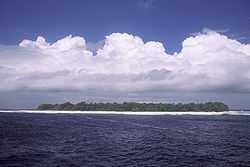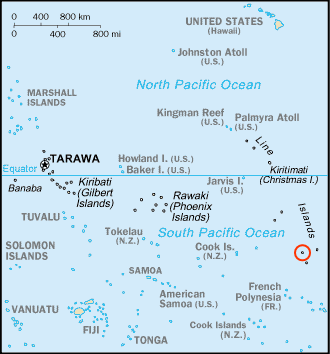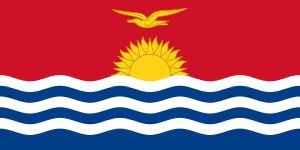Vostok Island

Vostok Island, also known as Staver Island, is an uninhabited coral island in the central Pacific Ocean, part of the Line Islands belonging to Kiribati. Other names for the island include "Anne Island", "Bostock Island", "Leavitts Island", "Reaper Island", "Wostock Island" or "Wostok Island". The island was first sighted in 1820 by the Russian explorer Fabian Gottlieb von Bellingshausen, who named the island for his ship Vostok (the name means "East" in Russian).[1]
Geography, flora and fauna

Vostok is located at 10°06′S 152°23′W / 10.100°S 152.383°WCoordinates: 10°06′S 152°23′W / 10.100°S 152.383°W,[2] and covers a land area of 24 hectares. Its nearest neighbors are Flint Island, 158 km south-southeast; Caroline Atoll, 230 km to the east; and Malden Island, 709 km north-northwest. It is 1.3 km in length, and is triangular-shaped.
Beaches on the island range between 25 and 50 meters wide, composed of coral sand and rubble. There is no lagoon or fresh water on the island, and no known freshwater lens.[3] Vostok's major portion is covered with a pure stand of Pisonia trees rooted in moist peat soil one meter thick. These trees, with heights of up to 30 meters, grow so densely that no other plants can grow beneath them. The herbs Boerhavia repens and Sesuvium portulac astrum round out the known vegetation.[3]
Coconut seedlings were planted on Vostok in 1922 and failed, although on the nearby islands of Caroline and Flint there are existing coconut palms.
Noteworthy fauna includes several species of seabirds, including the Red-footed Booby (Sula sula), Great Frigatebird (Fregata minor), Lesser Frigatebird (F. ariel), Black Noddy (Anous minutus), White Tern (Gygis alba), Masked Booby (Sula dactylatra), Brown Booby (S. leucogaster) and Brown Noddy (Anous stolidus). The Polynesian Rat and the Azure-tailed Skink (Emoia cyanura), together with Coconut Crabs and Green Turtles, completes the known land fauna.[3]
History
The island was first sighted in 1820 by the Russian explorer Fabian Gottlieb von Bellingshausen, who named the island for his ship Vostok (the name means "East" in Russian).[4] Vostok was claimed under the Guano Act of 1856, but was never mined for phosphate. It is unknown whether the island has ever been inhabited, although the presence of rats suggests that ancient Polynesians might have at least visited. No evidence of permanent settlement has ever been found.
Vostok formed part of the British Gilbert and Ellice Islands Colony, until becoming a part of newly independent Kiribati in 1979. American claims on the island were vacated in the Treaty of Tarawa in that same year.[5]
Vostok Island is currently designated as the Vostok Island Wildlife Sanctuary. Its isolated nature means it is rarely visited, save by the occasional scientist or yachter. Passengers aboard the Ocean Princess see it on the ships route from French Polynesia to Hawaii. Landing is said to be difficult, and no harbor or anchorage exists.[6]
Photo gallery
-

Wind-shorn Psionia trees on Vostok Island
-

Virgin forest of Psionia trees covering Vostok Island
-

Western coastline of Vostok Island
See also
References
- ↑ "Bellingshausen and the discovery of Antarctica". Polar Record (Cambridge University Press) 15 (99): 887–889. September 1971. doi:10.1017/S0032247400062112. Retrieved 6 January 2015.
- ↑ "UNEP World Conservation Monitoring Centre".
- ↑ 3.0 3.1 3.2 http://www.unep-wcmc.org/sites/wetlands/vostok_i.htm. Retrieved on 10 July 2008.
- ↑ "Bellingshausen and the discovery of Antarctica". Polar Record (Cambridge University Press) 15 (99): 887–889. September 1971. doi:10.1017/S0032247400062112. Retrieved 6 January 2015.
- ↑ US Department of State Background Note
- ↑ http://www.janeresture.com/kiribati_line/vostok.htm. Retrieved on 10 July 2008.
External links
- Article at Jane's Oceania Home Page - includes a sketch map
- Article at Looking For Nemo Expedition's site - includes photo and sketch map
- Oceandots - Vostok Island at the Wayback Machine (archived December 23, 2010) - satellite photograph
| |||||||||||||||||||||||||||||
